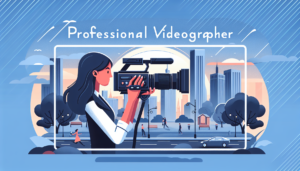Understanding Your Audience and Video Goals
Developing a keen awareness of who your audience is and what they seek is the cornerstone of creating impactful video content. Before you even press the record button, take a moment to delve into your potential viewers’ demographics, interests, and online behavior. This information will shape everything from the tone of your presentation to the platforms you choose for distribution. For instance, a younger audience may resonate more with a light-hearted and fast-paced video style on social platforms like TikTok or Instagram. In contrast, a more mature audience may prefer in-depth and informative content on platforms such as YouTube or embedded on a professional website.
It’s not just about knowing your audience but also understanding their pain points and how your video can address them. Do they seek entertainment, education, or a solution to a specific problem? When you identify this, you can tailor your content to provide value that directly speaks to their needs. This means breaking down complex topics for educational purposes if your audience craves understanding or showcasing product highlights that solve viewers’ dilemmas if they are searching for solutions. Utilizing engagement metrics and audience feedback can give you insights into what goals your content should strive to achieve.
Equally important is setting clear, attainable video goals. Are you aiming to increase brand awareness, generate leads, or drive traffic to your website? Your goals will inform the call-to-action you include and guide you on which key performance indicators (KPIs) matter the most for your content. For example, if brand awareness is the goal, you may focus on the number of shares and reach of your video, whereas for lead generation, the conversion rate from viewers to sign-ups would be more crucial. Therefore, aligning video objectives with audience expectations is critical in creating well-performing content.
Beyond these factors, consider the journey you want your viewers to take after watching your video. Will there be a series that they should follow? Is there a next step you want them to take towards becoming a customer or supporter of your brand? Outlining a clear viewer journey within your video strategy ensures you create a cohesive narrative across your productions, enhancing audience retention and loyalty over time.
Crafting Your Story: The Importance of a Strong Narrative
In storytelling, whether through novels, movies, or even marketing, a strong narrative is the backbone that captivates and engages your audience. An effective story is pivotal in creating a lasting impression and connecting with your readers or viewers. Within the framework of a narrative, characters, plots, and settings are not just mere components; they intertwine to convey core themes and messages that resonate with our fundamental human experiences.
At the heart of every memorable story is the ability to evoke emotions and provoke thought. When we consider the stories that have stayed with us long after the last page has turned, it’s often the emotional journey that we recall – the triumphs, the heartaches, and the underlying truths that stirred something within us. A powerful narrative taps into a wide spectrum of emotions, leveraging the universal language of empathy to bridge the gap between fiction and reality.
Moreover, crafting a compelling narrative is crucial in sustaining attention. In an era saturated with information and entertainment, a well-structured story is a beacon that cuts through the noise, drawing readers into its depths. Through skillful storytelling, the creator can maintain a rhythmic ebb and flow of tension and release, which keeps the audience invested in the narrative’s outcome. It differs between a passive glance and a deep, engaging experience.
Additionally, strategic narrative development can also be a powerful tool for persuasion and education. A strong story can serve as a mirror reflecting societal issues and a window into alternate perspectives. It can challenge preconceived notions and encourage critical thinking under the captivating guise of entertainment. With this in mind, the importance of a robust narrative is evident not just in creative pursuits but also in any communicative context where understanding and impact are desired outcomes.
Writing Tips for a Memorable Video Script
Creating a script that resonates with an audience and leaves a lasting impression requires certain strategies that tap into the psychology of storytelling and engagement. Understanding your audience is the critical first step in writing a memorable video script. This means delving into audience demographics, interests, and pain points. A script that speaks directly to the viewer’s experiences and desires will more likely hold their attention and create a connection that extends past the end of the video.
Incorporating storytelling elements is another method that contributes to a memorable script. Stories have been shared for millennia and have a unique way of sticking with us. By structuring your video script with a clear beginning, middle, and end, you give your message a narrative flow that is naturally engaging. Adding elements such as a relatable protagonist, a compelling conflict, and a satisfying resolution will help to make your script more impactful.
Clarity and conciseness are also crucial when scripting for video. Different from text-based content, video audiences typically have shorter attention spans. Simplifying your script helps ensure that your core message is delivered effectively without unnecessary fluff. Use plain language and short sentences to make your script easy to follow. Additionally, incorporating a mix of sentence lengths and rhythms can keep viewers engaged and enhance the overall impact of your delivery.
Call-to-action (CTA) is a vital element that should be noticed in a video script. A strong CTA prompts the viewer to take the next step, whether it is to subscribe to a channel, visit a website, or purchase a product. Your CTA should be clear and concise, providing viewers with a straightforward instruction on what to do once the video concludes. Framing the CTA within the context of the viewer’s benefit can significantly increase the likelihood of follow-through, making your script memorable and effective in achieving your video’s goals.
Technical Aspects of Script Formatting
When delving into the technical aspects of script formatting, a fundamental understanding of white space and its impact on readability is critical. The industry standard calls for the effective use of white space, which allows actors, directors, and producers to scan and interpret the text quickly. Typical scripts utilize a monospaced font, like Courier, set to 12-point size, ensuring each character occupies the same amount of horizontal space. This uniformity is essential for accurately estimating screen time, with the general rule of thumb being one page, equating to approximately one minute of screen time. Maintaining consistency across the entire script document is imperative to avoid pacing issues and timing inaccuracies.
Navigating the technical framework and script format involves specific alignment rules. Dialogue, character names, and scene headings each have their place on the page. For instance, character names are centered in capital letters, positioned above their dialogue, whereas dialogue blocks are indented 2.5 inches from the left edge of the page. Similarly, scene headings or slug lines are formatted in all caps and start 1.5 inches from the left margin, providing clear visual cues to distinguish the various elements. Mastery of these alignments promotes an uncluttered visual flow, offering a seamless reading experience for those involved in the production.
Additionally, attention to correctly using parentheticals is crucial to script formatting. Parentheticals provide specific instructions or context for how a line of dialogue should be delivered and are placed within the dialogue block just below the character name. Though they should be used sparingly to prevent dictating an actor’s performance, parentheticals value clarifying ambiguous lines or actions, ensuring the intended emotion or tone is conveyed. Misuse or overuse can lead to confusion, making the judicious application of these cues a technical requirement for any script.
Beyond spacing and alignment, script formatting software plays a vital role in adhering to industry standards. Modern scriptwriting software offers templates and automatic formatting options that enforce the proper use of margins, indents, and font requirements. This can be a game-changer for writers, as it minimizes manual formatting efforts and allows them to focus on narrative and character development. Utilizing these tools simplifies the writing process and ensures that technical specifications are met precisely, yielding a professional-quality script ready for production.
Revising and Editing: Polishing Your Script
[aib_post_related url=’/elementor-1476/’ title=’Jimeoin’ relatedtext=’You may also be interested in:’]
Embarking on the journey of scripting is just the initial step towards creating impactful content. Once the first draft is completed, a crucial phase begins: Revising and Editing. This process is fundamental in enhancing your script’s readability, flow, and structure, ensuring that your narrative resonates with your audience and achieves its intended purpose. Whether it’s for film, television, or digital media, effective revision rests on critically assessing your work and embracing creative improvement.
Start by revisiting the big picture of your script. Structure and pacing are key to a script that moves smoothly from one act to the next. Analyzing the script’s overall arc can reveal redundancies or gaps that need attention. Perhaps the introduction is too lengthy, or the climax arrives too abruptly. During revision, be brave enough to make the big cuts and alterations necessary to tighten your story’s progression. Developing a keen eye for balancing storytelling with engagement keeps the audience hooked until the final scene.
Once the structural integrity of the script is addressed, the focus shifts to dialogue and character development. Dialogue should advance the plot and give depth to your characters, making them relatable and intriguing. During the editing phase, read each line out loud. Does the conversation sound natural and engaging? Are the characters’ voices distinctive and consistent throughout the script? These vital questions guide the polishing process, ensuring that every word spoken contributes meaningfully to the story.
[aib_post_related url=’/elementor-1483/’ title=’Everlast’ relatedtext=’You may also be interested in:’]
Another critical aspect of revising and editing is to hunt down any grammatical errors, spelling mistakes, or formatting inconsistencies. Industry standards dictate specific guidelines for script formatting, and adhering to these conventions is non-negotiable. Attention to detail demonstrates professionalism and respect for the reader’s expectations. A meticulously edited script, free from distracting errors, allows the reader—or viewer—to remain immersed in the narrative world you’ve painstakingly crafted.















